How to Maintain Sustainable Development of China’s Agriculture under the Restriction of Production Resources? Research with Respect to the Effect on Output of the Substitution of Input Factors
Abstract
:1. Introduction
1.1. Research Background
1.2. Research Motivation
2. Materials and Methods
2.1. Translog Production Function Model
2.2. Derivation of Output Elasticity and Substitution Elasticity
2.3. Regression Approach—Ridge Regression
3. Results
3.1. Data Source Description
3.2. Model Determination
3.3. Multicollinearity Analysis
3.4. Results of Ridge Regression and Model Characteristics
4. Discussions
4.1. Output Elasticities
4.2. Substitution Elasticities
4.3. Differences in Technological Progress between Production Factors
4.4. Important Information for the Management of Agricultural Water, Energy and Land Resources
5. Conclusions
Author Contributions
Funding
Institutional Review Board Statement
Informed Consent Statement
Data Availability Statement
Conflicts of Interest
References
- Cao, X.C.; Wu, M.Y.; Guo, X.P.; Zheng, Y.L.; Gong, Y.; Wu, N.; Wang, W.G. Assessing water scarcity in agricultural production system based on the generalized water resources and water footprint framework. Sci. Total Environ. 2017, 609, 587–597. [Google Scholar]
- Huang, Y.; Li, Y.P.; Chen, X.; Ma, Y.G. Optimization of the irrigation water resources for agricultural sustainability in Tarim River Basin, China. Agric. Water Manag. 2012, 107, 74–85. [Google Scholar] [CrossRef]
- Mushtaq, S.; Khan, S.; Dawe, D.; Hanjra, M.A.; Hafeez, M.; Asghar, M.N. Evaluating the impact of Tax-for-Fee reform (Fei Gai Shui) on water resources and agriculture production in the Zhanghe Irrigation System, China. Food Policy 2008, 33, 576–586. [Google Scholar] [CrossRef] [Green Version]
- Wang, F.T.; Yu, C.; Xiong, L.C.; Chang, Y. How can agricultural water use efficiency be promoted in China? A spatial-temporal analysis. Resour. Conserv. Recycl. 2019, 145, 411–418. [Google Scholar] [CrossRef]
- Zhao, R.Q.; Liu, Y.; Tian, M.M.; Ding, M.L.; Cao, L.H.; Zhang, Z.P.; Chuai, X.W.; Xiao, L.G.; Yao, L.G. Impacts of water and land resources exploitation on agricultural carbon emissions: The water-land-energy-carbon nexus. Land Use Policy 2018, 72, 480–492. [Google Scholar] [CrossRef]
- Geng, Q.L.; Ren, Q.F.; Nolan, R.H.; Wu, P.T.; Yu, Q. Assessing China’s agricultural water use efficiency in a green-blue water perspective: A study based on data envelopment analysis. Ecol. Indic. 2019, 96, 329–335. [Google Scholar] [CrossRef]
- Shen, X.B.; Lin, B.Q. The shadow prices and demand elasticities of agricultural water in China: A StoNED-based analysis. Resour. Conserv. Recycl. 2017, 127, 21–28. [Google Scholar] [CrossRef]
- Smith, L.; Inman, A.; Xin, L.; Zhang, H.F.; Meng, F.Q.; Zhou, J.B.; Burke, S.; Rahn, C.; Siciliano, G.; Haygarth, P.M.; et al. Mitigation of diffuse water pollution from agriculture in England and China, and the scope for policy transfer. Land Use Policy 2017, 61, 208–219. [Google Scholar] [CrossRef] [Green Version]
- Liao, L.W.; Long, H.L.; Gao, X.L.; Ma, E.P. Effects of land use transitions and rural aging on agricultural production in China’s farming area: A perspective from changing labor employing quantity in the planting industry. Land Use Policy 2019, 88, 104152. [Google Scholar] [CrossRef]
- Wang, C.; Siriwardana, M.; Meng, S. Effects of the Chinese arable land fallow system and land-use change on agricultural production and on the economy. Econ. Model. 2019, 79, 186–197. [Google Scholar] [CrossRef]
- Johnston, B.F.; Mellor, J.W. The role of agriculture in economic development. Am. Econ. Rev. 1961, 51, 566–593. [Google Scholar]
- Garciabarrios, R.; Garciabarrios, L. Environmental and technological degradation in peasant agriculture: A consequence of development in Mexico. World Dev. 1990, 18, 1569–1585. [Google Scholar] [CrossRef]
- Kwan, F.; Wu, Y.R.; Zhuo, S.H. Surplus agricultural labour and China’s Lewis turning point. China Econ. Rev. 2018, 48, 244–257. [Google Scholar] [CrossRef]
- Zhang, X.B.; Yang, J.; Thomas, R. Mechanization outsourcing clusters and division of labor in Chinese agriculture. China Econ. Rev. 2017, 43, 184–195. [Google Scholar] [CrossRef]
- Hayami, Y.; Ruttan, V.W. Factor prices and technical change in agricultural development: The United States and Japan, 1880–1960. J. Political Econ. 1970, 78, 1115–1141. [Google Scholar] [CrossRef]
- Babin, F.G.; Willis, C.E.; Allen, P.G. Estimation of substitution possibilities between water and other production inputs. Am. J. Agric. Econ. 1982, 64, 148–151. [Google Scholar] [CrossRef]
- Cai, X.M.; Ringler, C.; You, J.Y. Substitution between water and other agricultural inputs: Implications for water conservation in a River Basin context. Ecol. Econ. 2008, 66, 38–50. [Google Scholar] [CrossRef]
- Edwards, B.K.; Howitt, R.E.; Flaim, S.J. Fuel, crop, and water substitution in irrigated agriculture. Resour. Energy Econ. 1996, 18, 311–331. [Google Scholar] [CrossRef]
- Kirby, M.; Bark, R.; Connor, J.; Qureshi, M.E.; Keyworth, S. Sustainable irrigation: How did irrigated agriculture in Australia’s Murray–Darling Basin adapt in the Millennium Drought. Agric. Water Manag. 2014, 145, 154–162. [Google Scholar] [CrossRef]
- Shani, U.; Tsur, Y.; Zemel, A.; Zilberman, D. Irrigation production functions with water-capital substitution. Agric. Econ. 2009, 40, 55–66. [Google Scholar] [CrossRef] [Green Version]
- Shao, S.; Yang, Z.B.; Yang, L.L.; Zhang, X.; Geng, Y. Synergetic conservation of water and energy in China’s industrial sector: From the perspectives of output and substitution elasticities. J. Environ. Manag. 2020, 259, 110045. [Google Scholar] [CrossRef] [PubMed]
- Wang, F.; Jiang, Y.J.; Zhang, W.L.; Yang, F. Elasticity of factor substitution and driving factors of energy intensity in China’s industry. Energy Environ. 2019, 30, 385–407. [Google Scholar] [CrossRef]
- Apostolakis, B.E. Energy-capital substitutability/complementarity: The dichotomy. Energy Econ. 1990, 12, 48–58. [Google Scholar] [CrossRef]
- Blackorby, C.; Russell, R.R. Will the real elasticity of substitution please stand up? (A comparison of the Allen/Uzawa and Morishima elasticities). Am. Econ. Rev. 1989, 79, 882–888. [Google Scholar]
- Griffin, J.M.; Gregory, P.R. An intercountry translog model of energy substitution responses. Am. Econ. Rev. 1976, 66, 845–857. [Google Scholar]
- Thompson, P.; Taylor, T.G. The capital-energy substitutability debate: A new look. Rev. Econ. Stat. 1995, 77, 565–569. [Google Scholar] [CrossRef]
- Arnberg, S.; Bjorner, T.B. Substitution between energy, capital and labour within industrial companies: A micro panel data analysis. Resour. Energy Econ. 2007, 29, 122–136. [Google Scholar] [CrossRef]
- Christopoulos, D.K. The demand for energy in Greek manufacturing. Energy Econ. 2000, 22, 569–586. [Google Scholar] [CrossRef]
- Solow, J.L. The capital-energy complementarity debate revisited. Am. Econ. Rev. 1987, 77, 605–614. [Google Scholar]
- Anderson, K.; Hayami, Y.; Mulgan, A.G. The Political Economy of Agricultural Protection: East Asia in International Perspective; Allen & Unwin in Association with the Australia-Japan Research Centre, Australian National University: Sydney, Australia, 1986; pp. 169–176. [Google Scholar]
- Christensen, L.R. Conjugate duality and the transcendental logarithmic prodcution function. Econometrica 1971, 39, 255–256. [Google Scholar]
- Alizadeh, P.; Mohammadi, H.; Shahnoushi, N.; Saghaian, S.; Pooya, A. Evaluating Cost Structure and Economies of Scale of Beef Cattle Fattening Farms in Mashhad City. J. Agric. Sci. Technol. 2019, 21, 1753–1766. [Google Scholar]
- Ashayeri, M.S.; Khaledian, M.R.; Kavoosi-Kalashami, M.; Rezaei, M. The economic value of irrigation water in paddy farms categorized according to mechanization levels in Guilan province, Iran. Agric. Water Manag. 2018, 202, 195–201. [Google Scholar] [CrossRef]
- Lavee, D.; Bahar, S. Examining the economies of scale of water and sewage utilities in the urban sector: The case of Israel. Water Policy 2017, 19, 257–270. [Google Scholar] [CrossRef]
- Lin, B.Q.; Luan, R.R. Are government subsidies effective in improving innovation efficiency? Based on the research of China’s wind power industry. Sci. Total Environ. 2020, 710, 136339. [Google Scholar] [CrossRef] [PubMed]
- Onumah, E.E.; Onumah, J.A.; Onumah, G.E. Production risk and technical efficiency of fish farms in Ghana. Aquaculture 2018, 495, 55–61. [Google Scholar] [CrossRef]
- Rossi, F.R.; de Souza, H.M.; Miranda, B.V.; Carrer, M.J. The role of contracts in the adoption of irrigation by Brazilian orange growers. Agric. Water Manag. 2020, 233, 106078. [Google Scholar] [CrossRef]
- Hoerl, A.E.; Kennard, R.W. Ridge regression: Biased estimation for nonorthogonal problems. Technometrics 1970, 12, 55–67. [Google Scholar] [CrossRef]
- Wu, Y.R. China’s capital stock series by region and sector. Front. Econ. China 2016, 11, 156–172. [Google Scholar]
- Lin, B.; Raza, M.Y. Fuels substitution possibilities and the technical progress in Pakistan’s agriculture sector. J. Clean. Prod. 2021, 314, 128021. [Google Scholar] [CrossRef]
- Takeshima, H.; Nin-Pratt, A.; Diao, X. Mechanization and agricultural technology evolution, agricultural intensification in sub-Saharan Africa: Typology of agricultural mechanization in Nigeria. Am. J. Agric. Econ. 2013, 95, 1230–1236. [Google Scholar] [CrossRef] [Green Version]
- Suh, D.H. Declining energy intensity in the US agricultural sector: Implications for factor substitution and technological change. Sustainability 2015, 7, 13192–13205. [Google Scholar] [CrossRef] [Green Version]
- Smyth, R.; Narayan, P.K.; Shi, H.L. Inter-fuel substitution in the Chinese iron and steel sector. Int. J. Prod. Econ. 2012, 139, 525–532. [Google Scholar] [CrossRef]
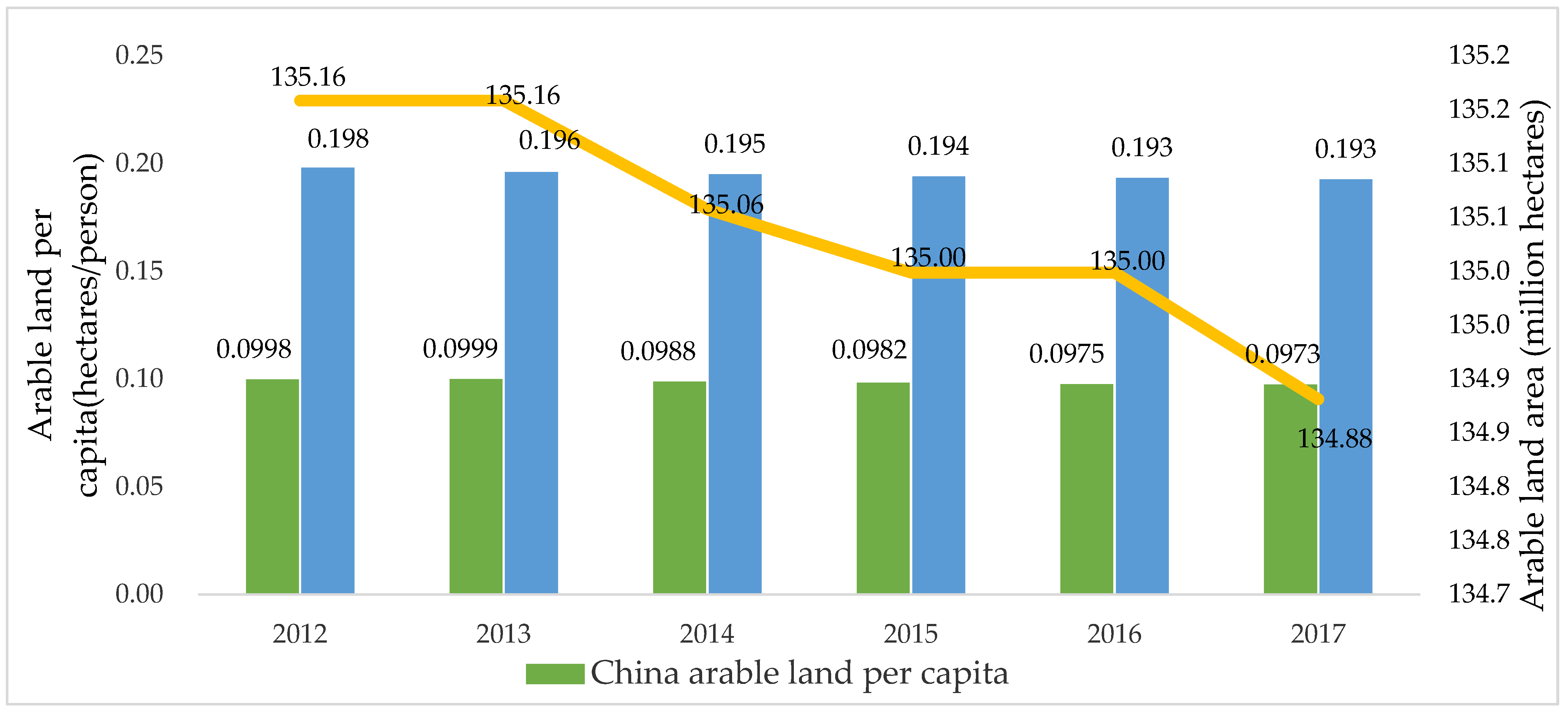
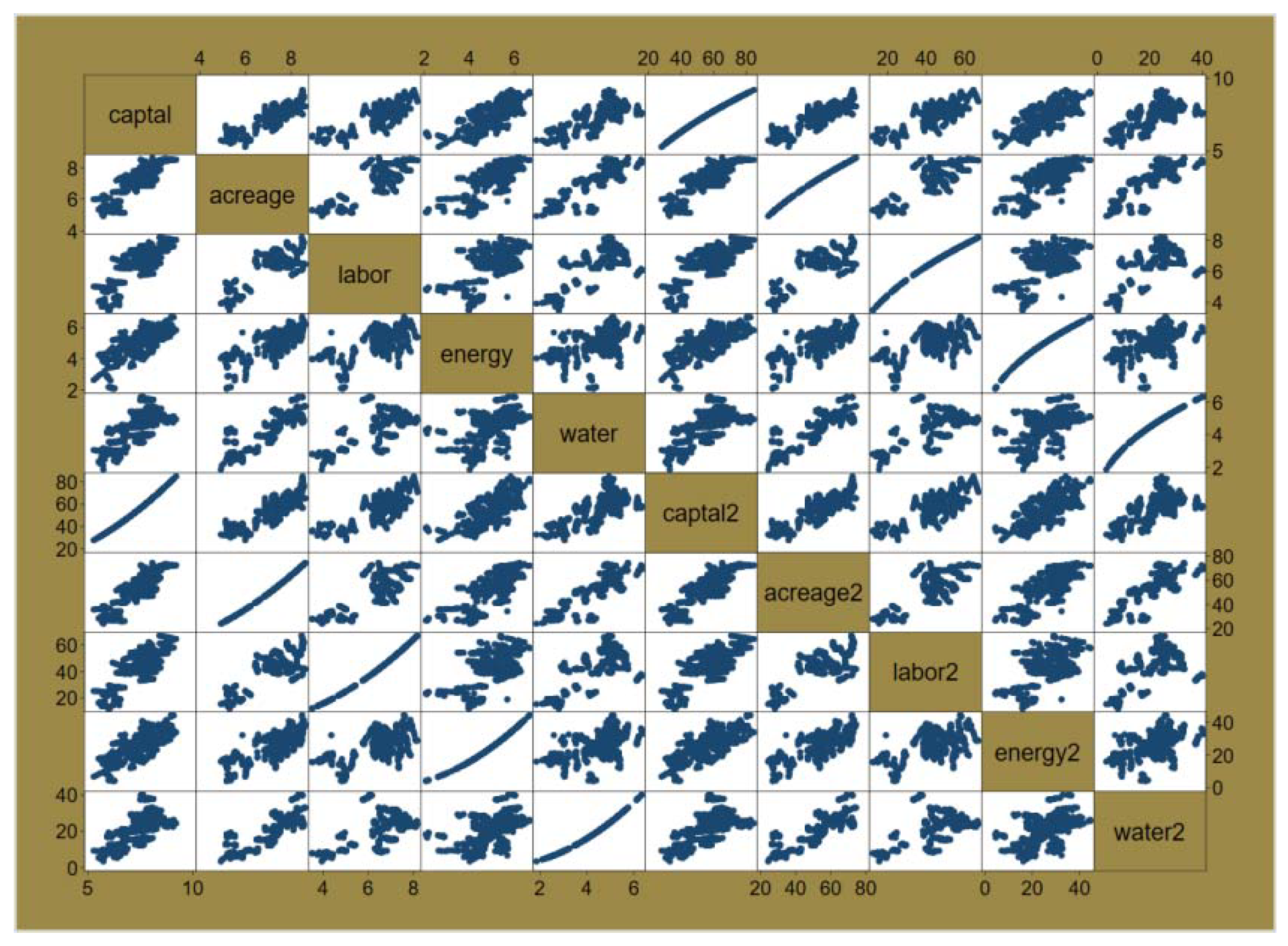
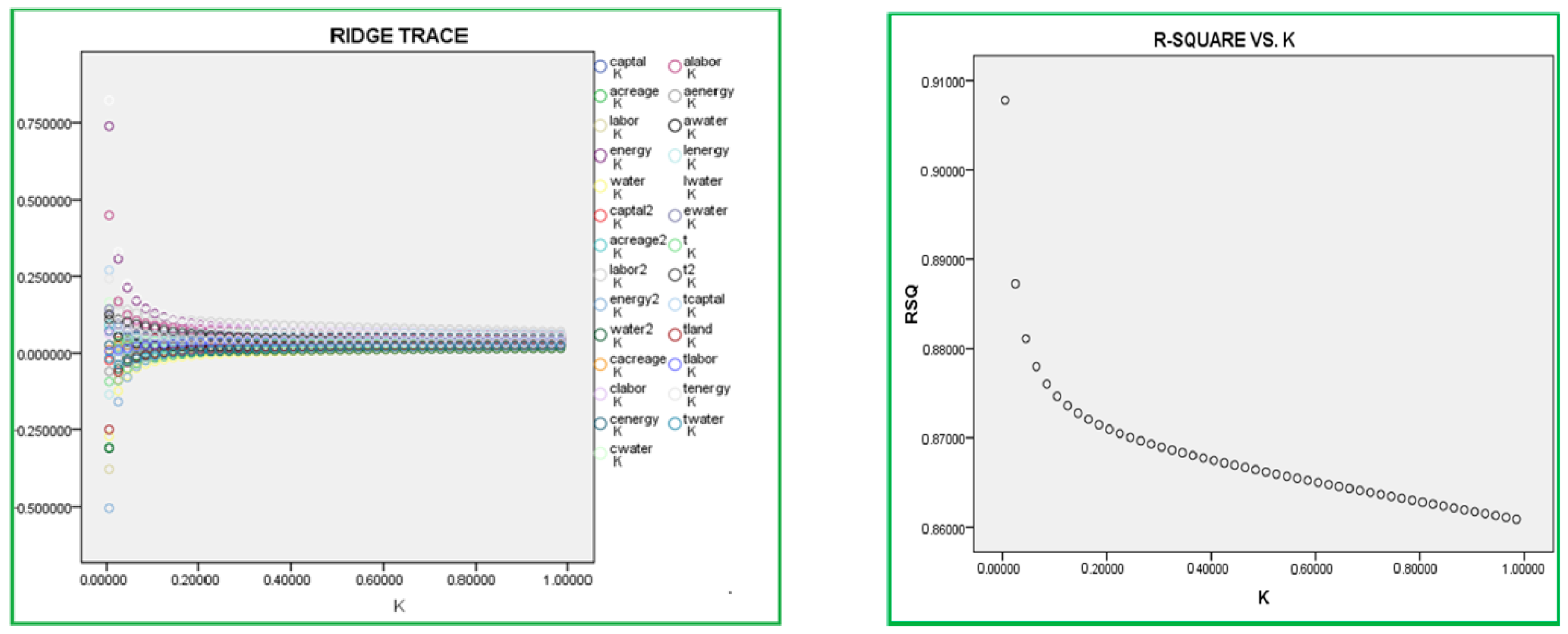
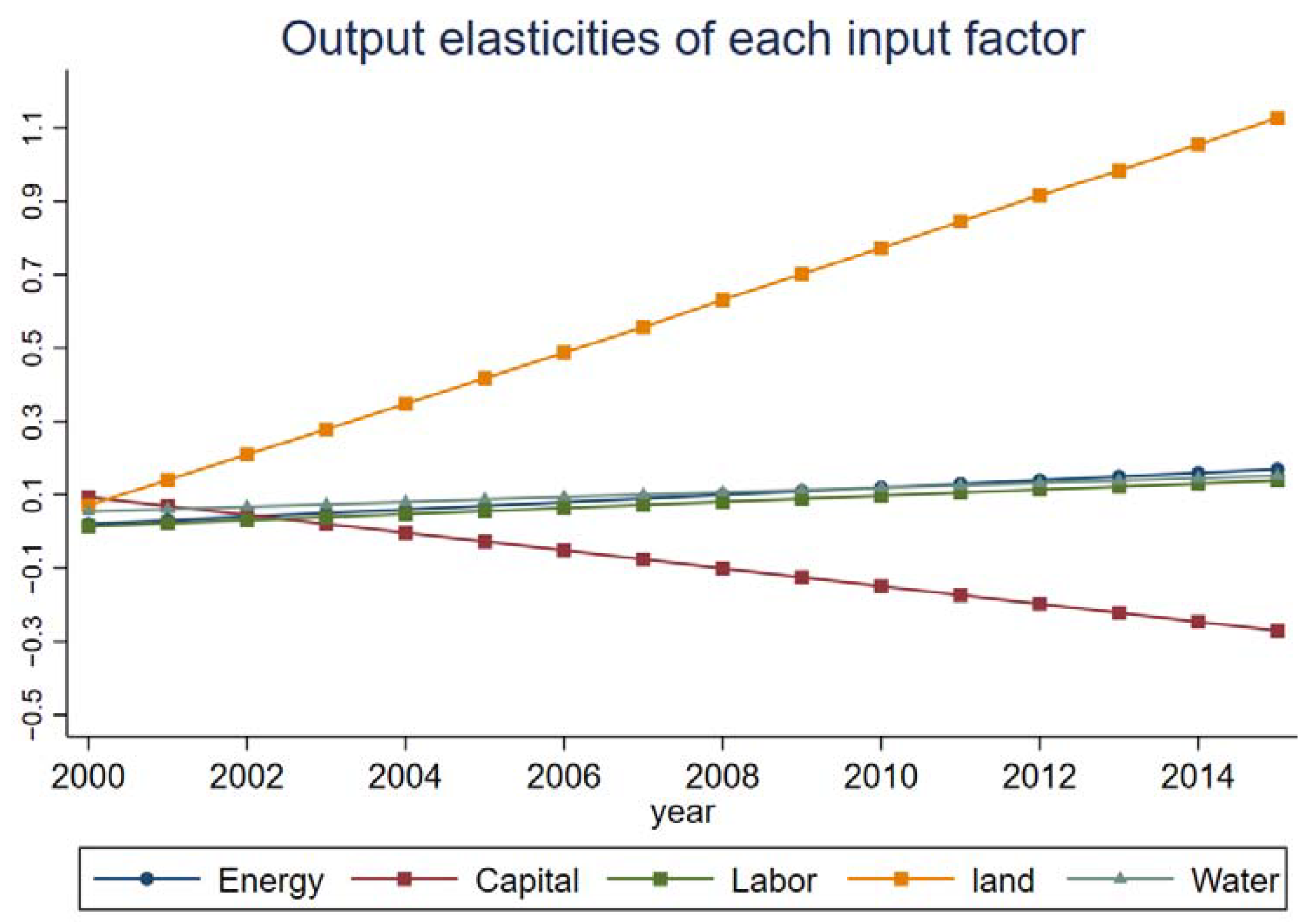
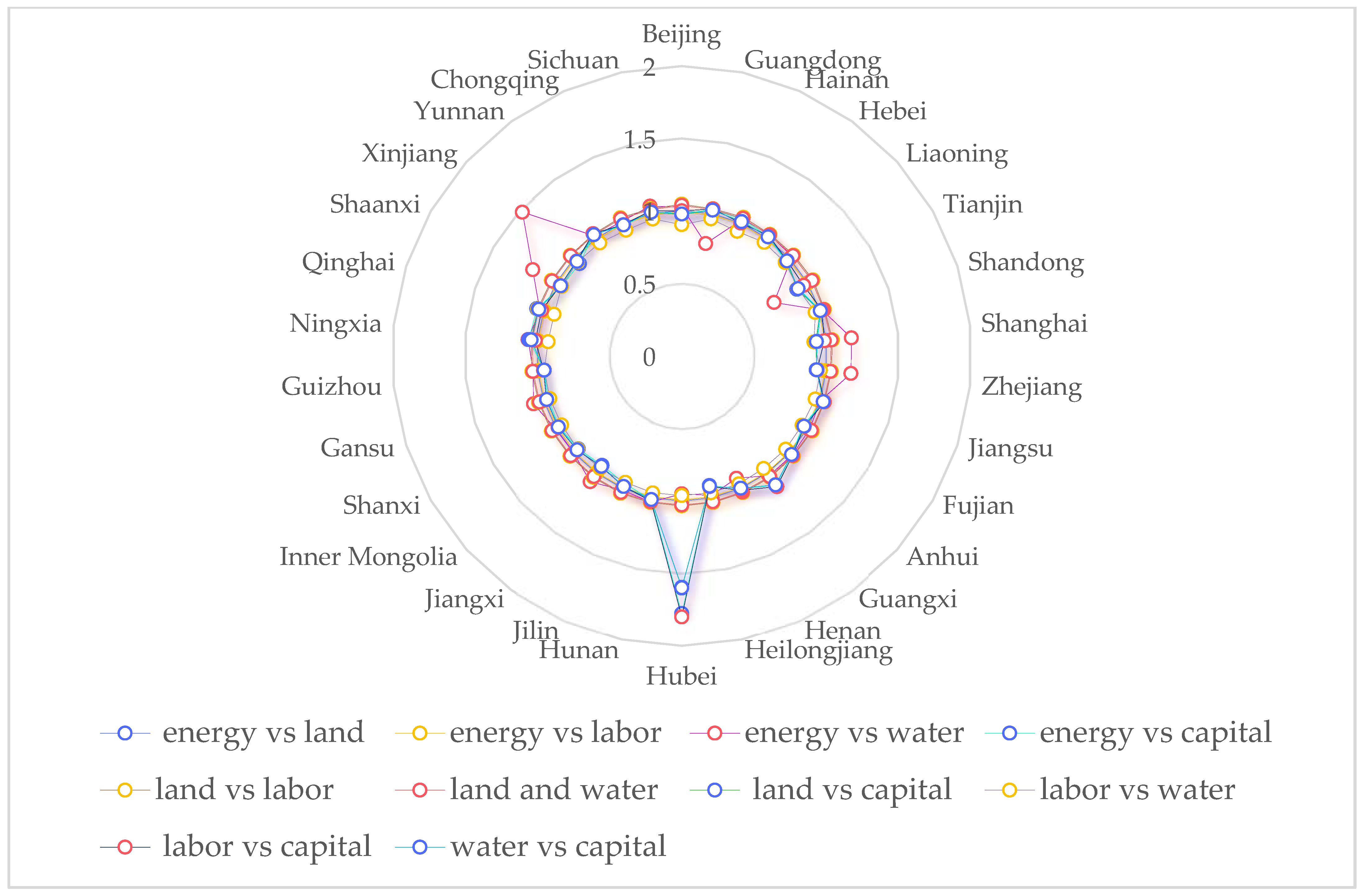

| Statistic | Obs | Mean | Std. Dev. | Min | Max |
|---|---|---|---|---|---|
| Y | 480 | 6.7370 | 0.9614 | 4.0427 | 8.5228 |
| capital | 480 | 7.3704 | 0.8510 | 5.2903 | 9.1970 |
| land | 480 | 7.1956 | 0.9803 | 4.9225 | 8.6181 |
| labor | 480 | 6.4551 | 1.0846 | 3.5080 | 8.1771 |
| energy | 480 | 5.0288 | 0.8741 | 2.0754 | 6.6687 |
| water | 480 | 4.4473 | 0.9503 | 1.8563 | 6.3310 |
| Tests | The Results of Statistic | p Value |
|---|---|---|
| Hausman tests (chi2) | 75 | 0.000 |
| Variable | VIF | Variable |
|---|---|---|
| maximum | 18,004.28 | C acreage |
| minimum | 820 | labor |
| average | 3558.15 |
| Ridge k Value = 0.10000 | Ordinary Ridge Regression | |||||
|---|---|---|---|---|---|---|
| Sample Size = 480 | Cross Sections Number = 30 | |||||
| Wald Test = 3912.9695 | p-Value > chi2(27) = 0.0000 | |||||
| F-Test = 144.9248 | p-Value > F(27, 423) = 0.0000 | |||||
| (Buse 1973) R2 = 0.9920 | Raw Moments R2 = 0.9998 | |||||
| (Buse 1973) R2 Adj = 0.9910 | Raw Moments R2 Adj = 0.9998 | |||||
| Root MSE (Sigma) = 0.0912 | Log Likelihood Function = 498.5156 | |||||
| R2h = 0.5816 R2h Adj= 0.5263 F-Test = 23.28 p-Value > F(27, 423) 0.0000 R2v = 0.1216 R2v Adj= 0.0053 F-Test = 2.32 p-Value > F(27, 423) 0.0003 | ||||||
| Variable | Coefficient | Std. Error | t-Statistic | p-value | 95% Conf. Interval | |
| capital | 0.02091 | 0.00346 | 6.04 | 0.000 | [0.01410, 0.02772] | |
| acreage | 0.02072 | 0.00338 | 6.14 | 0.000 | [0.01408, 0.02735] | |
| labor | −0.00209 | 0.00255 | −0.82 | 0.415 | [−0.00710, 0.00293] | |
| energy | 0.00666 | 0.00394 | 1.69 | 0.092 | [−0.00109, 0.01441] | |
| water | 0.00903 | 0.00322 | 2.81 | 0.005 | [0.00270, 0.01535] | |
| capital2 | 0.00084 | 0.00022 | 3.79 | 0.000 | [0.00041, 0.00128] | |
| acreage2 | 0.00158 | 0.00024 | 6.63 | 0.000 | [0.00111, 0.00205] | |
| labor2 | 0.00008 | 0.00022 | 0.37 | 0.712 | [−0.00035, 0.00051] | |
| energy2 | −0.00088 | 0.00041 | −2.12 | 0.035 | [−0.00169, −0.00006] | |
| water2 | 0.00117 | 0.00039 | 2.98 | 0.003 | [0.00040, 0.00195] | |
| C acreage | 0.00133 | 0.00017 | 7.62 | 0.000 | [0.00099, 0.00168] | |
| C labor | 0.00063 | 0.00019 | 3.42 | 0.001 | [0.00027, 0.00100] | |
| C energy | 0.00045 | 0.00022 | 2.05 | 0.041 | [0.00002, 0.00088] | |
| C water | 0.00157 | 0.00025 | 6.32 | 0.000 | [0.00108, 0.00206] | |
| A labor | 0.00084 | 0.00019 | 4.34 | 0.000 | [0.00046, 0.00122] | |
| A energy | 0.00126 | 0.00022 | 5.65 | 0.000 | [0.00082, 0.00170] | |
| A water | 0.00148 | 0.00025 | 5.84 | 0.000 | [0.00098, 0.00198] | |
| L energy | 0.00028 | 0.00026 | 1.05 | 0.294 | [−0.00024, 0.00079] | |
| L water | 0.00072 | 0.00026 | 2.82 | 0.005 | [0.00022, 0.00123] | |
| E water | 0.00174 | 0.00034 | 5.05 | 0.000 | [0.00106, 0.00242] | |
| t | 0.00983 | 0.00087 | 11.30 | 0.000 | [0.00812, 0.01154] | |
| t2 | 0.00034 | 0.00008 | 4.18 | 0.000 | [0.00018, 0.00050] | |
| T capital | 0.0006539 | 0.0000403 | 16.24 | 0.000 | [0.00057, 0.00073] | |
| T land | 0.0009618 | 0.0000651 | 14.77 | 0.000 | [0.00083, 0.00109] | |
| T labor | 0.0010027 | 0.0001148 | 8.73 | 0.000 | [0.00078, 0.00123] | |
| T energy | 0.0006518 | 0.0001336 | 4.88 | 0.000 | [0.00039, 0.00091] | |
| T water | 0.0018607 | 0.0001865 | 9.98 | 0.000 | [0.00149, 0.00223] | |
| _cons | 5.49917 | 0.1567579 | 35.08 | 0.000 | [5.1910, 5.8072] | |
| Energy | Capital | Labor | Land | Water | |
|---|---|---|---|---|---|
| 2000 | 0.0203 | 0.0933 | 0.0141 | 0.0710 | 0.0543 |
| 2001 | 0.0302 | 0.0692 | 0.0224 | 0.1404 | 0.0609 |
| 2002 | 0.0401 | 0.0450 | 0.0308 | 0.2098 | 0.0674 |
| 2003 | 0.0501 | 0.0206 | 0.0390 | 0.2782 | 0.0736 |
| 2004 | 0.0600 | −0.0035 | 0.0474 | 0.3477 | 0.0804 |
| 2005 | 0.0697 | −0.0275 | 0.0558 | 0.4174 | 0.0873 |
| 2006 | 0.0796 | −0.0516 | 0.0642 | 0.4872 | 0.0940 |
| 2007 | 0.0896 | −0.0762 | 0.0724 | 0.5567 | 0.1001 |
| 2008 | 0.0997 | −0.1005 | 0.0808 | 0.6312 | 0.1065 |
| 2009 | 0.1096 | −0.1248 | 0.0890 | 0.7014 | 0.1129 |
| 2010 | 0.1194 | −0.1492 | 0.0973 | 0.7726 | 0.1193 |
| 2011 | 0.1294 | −0.1735 | 0.1056 | 0.8443 | 0.1257 |
| 2012 | 0.1394 | −0.1977 | 0.1140 | 0.9163 | 0.1323 |
| 2013 | 0.1494 | −0.2220 | 0.1222 | 0.9830 | 0.1385 |
| 2014 | 0.1594 | −0.2463 | 0.1305 | 1.0545 | 0.1449 |
| 2015 | 0.1694 | −0.2706 | 0.1388 | 1.1273 | 0.1514 |
| Year | Energy vs. Land | Energy vs. Labor | Energy vs. Water | Energy vs. Capital | Land vs. Labor | Land vs. Water | Land vs. Capital | Labor vs. Water | Labor vs. Capital | Water vs. Capital |
|---|---|---|---|---|---|---|---|---|---|---|
| 2000 | 1.0070 | 0.9918 | 1.0264 | 1.0011 | 1.1605 | 1.1062 | 1.0016 | 1.0030 | 1.0049 | 1.0155 |
| 2001 | 1.0053 | 0.9917 | 1.0191 | 0.9913 | 1.0906 | 1.0527 | 1.0310 | 0.9963 | 1.0016 | 1.0179 |
| 2002 | 1.0039 | 0.9926 | 1.0123 | 0.9392 | 1.0636 | 1.0431 | 1.0446 | 0.9903 | 1.0174 | 1.0483 |
| 2003 | 1.0030 | 0.9935 | 1.0052 | 1.0947 | 1.0492 | 1.0378 | 1.0394 | 0.9847 | 1.1286 | 1.0404 |
| 2004 | 1.0025 | 0.9941 | 0.9975 | 1.3768 | 1.0400 | 1.0338 | 1.2571 | 0.9797 | 1.3883 | 1.2594 |
| 2005 | 1.0021 | 0.9945 | 0.9881 | 0.9466 | 1.0337 | 1.0306 | 0.9359 | 0.9750 | 0.9465 | 0.9361 |
| 2006 | 1.0018 | 0.9949 | 0.9687 | 0.9762 | 1.0291 | 1.0281 | 0.9679 | 0.9703 | 0.9759 | 0.9680 |
| 2007 | 1.0016 | 0.9954 | 0.9630 | 0.9852 | 1.0257 | 1.0262 | 0.9785 | 0.9645 | 0.9848 | 0.9786 |
| 2008 | 1.0014 | 0.9959 | 0.9054 | 0.9894 | 1.0229 | 1.0244 | 0.9838 | 0.9589 | 0.9890 | 0.9839 |
| 2009 | 1.0013 | 0.9962 | 0.9465 | 0.9918 | 1.0207 | 1.0229 | 0.9870 | 0.9527 | 0.9914 | 0.9871 |
| 2010 | 1.0012 | 0.9964 | 1.1215 | 0.9933 | 1.0189 | 1.0215 | 0.9892 | 0.9457 | 0.9930 | 0.9892 |
| 2011 | 1.0011 | 0.9966 | 1.2519 | 0.9944 | 1.0174 | 1.0203 | 0.9907 | 0.9377 | 0.9941 | 0.9907 |
| 2012 | 1.0010 | 0.9969 | 1.1410 | 0.9951 | 1.0161 | 1.0193 | 0.9918 | 0.9284 | 0.9949 | 0.9919 |
| 2013 | 1.0009 | 0.9971 | 1.0928 | 0.9957 | 1.0150 | 1.0184 | 0.9927 | 0.9156 | 0.9955 | 0.9928 |
| 2014 | 1.0009 | 0.9972 | 1.0667 | 0.9962 | 1.0140 | 1.0175 | 0.9935 | 0.8987 | 0.9960 | 0.9935 |
| 2015 | 1.0008 | 0.9974 | 1.0543 | 0.9966 | 1.0132 | 1.0167 | 0.9940 | 0.8742 | 0.9963 | 0.9941 |
| Author | Research Country | Research Time Period | Substitution Elasticities (Field of Agricultural Research) |
|---|---|---|---|
| Lin, B., Raza M. Y. | Pakistan | 1980–2018 | Capital vs. energy (1.34–2.06) Capital vs. labor (1.59–2.04) Labor vs. energy (1.74–2.44) |
| Takeshima, H., Nin-Pratt, A., Diao, X. | Nigeria | 2010 | Labor vs. energy |
| Suh, D. H. | America | 1960–1964,2000–2004 | Capital vs. energy Capital vs. labor Labor vs. energy |
Publisher’s Note: MDPI stays neutral with regard to jurisdictional claims in published maps and institutional affiliations. |
© 2022 by the authors. Licensee MDPI, Basel, Switzerland. This article is an open access article distributed under the terms and conditions of the Creative Commons Attribution (CC BY) license (https://creativecommons.org/licenses/by/4.0/).
Share and Cite
Li, H.; He, Q.; Liu, C.; Dai, W.; Fei, R. How to Maintain Sustainable Development of China’s Agriculture under the Restriction of Production Resources? Research with Respect to the Effect on Output of the Substitution of Input Factors. Energies 2022, 15, 3794. https://doi.org/10.3390/en15103794
Li H, He Q, Liu C, Dai W, Fei R. How to Maintain Sustainable Development of China’s Agriculture under the Restriction of Production Resources? Research with Respect to the Effect on Output of the Substitution of Input Factors. Energies. 2022; 15(10):3794. https://doi.org/10.3390/en15103794
Chicago/Turabian StyleLi, Huaicheng, Qing He, Chenming Liu, Wei Dai, and Rilong Fei. 2022. "How to Maintain Sustainable Development of China’s Agriculture under the Restriction of Production Resources? Research with Respect to the Effect on Output of the Substitution of Input Factors" Energies 15, no. 10: 3794. https://doi.org/10.3390/en15103794
APA StyleLi, H., He, Q., Liu, C., Dai, W., & Fei, R. (2022). How to Maintain Sustainable Development of China’s Agriculture under the Restriction of Production Resources? Research with Respect to the Effect on Output of the Substitution of Input Factors. Energies, 15(10), 3794. https://doi.org/10.3390/en15103794





